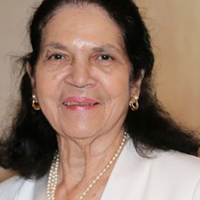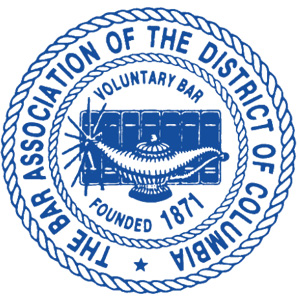“Chocolate City” Authors Speak at Pro Bono Partnership Luncheon
October 28, 2019
How race played a key role in shaping Washington, D.C.’s political, social, and economic landscape was the focus of this year’s Pro Bono Partnership Annual Luncheon, organized by the D.C. Bar Pro Bono Center and held on Oct. 22 at Akin Gump Strauss Hauer & Feld LLP.
Comprising more than 100 District law firms and federal agencies that are committed to pro bono work, the Pro Bono Partnership Program sponsors meetings that allow legal services organizations to present their emerging needs. The meetings also provide opportunities for firms to exchange ideas about enhancing their pro bono activities.
In light of rising gentrification in the District, an issue that profoundly affects the 16 percent of city residents — many of whom are people of color — who live below the federal poverty line, the Pro Bono Center invited Chris Myers Asch and George Derek Musgrove, the authors of Chocolate City: A History of Race and Democracy in the Nation’s Capital, to discuss their book.
“D.C. [has been] a chocolate city from its inception through present day,” said Asch, a history teacher at Maine’s Colby College. “The presence of a large, vibrant black population has been central to the story of D.C. from the beginning,” he said, noting that much of the city was literally built by enslaved African Americans, who made up about a third of the city’s population. By 1830, the majority of the black population was free. They created a lively free-black community that was unlike anything else in the country. They were starting private schools for black students. They were starting black churches. The District became an oasis and a beacon of freedom adjacent to the larger slave states. Black people escaping slavery found refuge in Washington, D.C.
After the Civil War, the city’s black population tripled. The District became the vanguard of a social revolution during Reconstruction. “Black men in D.C. became the first black people in the country to cast legal ballots. Black people flooded into the city to teach at Howard University and work in the federal government. They built what becomes by the late 19th century the largest, most prosperous, best educated black community in the entire country,” Asch said.
“Chocolate City” has long been a nickname for the District because of its significant black population. It even inspired the title track of Parliament’s 1975 funk record, said Musgrove, an associate professor of history at the University of Maryland, Baltimore County. “’Chocolate City’ for us and many other people roughly [denotes] the 1960s through the late 1990s. D.C. was the first major American city to gain a black majority in 1957. That black majority went up to about 73 percent in the 1970s. And it remained in the 70 percent range through the 1990s. D.C. was one of the blackest cities in the country,” Musgrove noted.
“During this period, D.C. was gaining democracy for the first time in a hundred years,” added Musgrove. “During the 1870s, all D.C. residents — white, black, the high and the low — were stripped of the vote. They couldn’t even vote for dog-catcher. But starting in the 1960s, black residents slowly but surely began to get democratic governance within the city. We got a school board just a month after the 1968 riots. In 1971, we got our first non-voting delegate in Congress with Walter Fauntroy. In 1974, we began establishing a city government — the council and mayor, who are elected as opposed to being appointed. All of this came together when you had this remarkable group of people who were coming into the city and taking advantage of the return of democracy, the black majority. We were the only city that elected a Black Power activist as its mayor — Marion Barry in 1978.”
Today, with shifting demographics coinciding with rapid redevelopment and a skyrocketing cost of living, that black majority is eroding. Nearly a decade ago when Asch and Musgrove started writing their book, the U.S. Census report noted that in 2011, D.C. for the first time in several generations was losing its black majority. And the history and the preservation of it became hot, sometimes contentious topics. “We had new residents who didn’t really understand why large numbers of older residents were angry,” Musgrove said. “And you had a lot of older residents who were very anxious to make sure that the history they knew wasn’t slipping away. They thought that people who were coming into the city should know what they had experienced and that they had a champion within the historic record. All these different groups needed a book like this.”
After introducing the authors, Brian Rohal, a housing attorney of the day at the Pro Bono Center, said that Chocolate City is “one of the only comprehensive histories of D.C. — both politically and socially — focusing on race and participation in local and national government.” Before Rohal worked for the Pro Bono Center, he taught high school mainly in southeast D.C. That experience allowed him to see the city through the eyes of teenagers from Ward 8. “That’s a very different view from how people in law firms view life,” said Rohal. “It was tough to get students to engage with [D.C. history]. Teachers are usually trying to find other materials to really tell the stories that students are missing.”
Fortunately, Rohal met Asch, who in turn shared some forthcoming paragraphs of Chocolate City. Rohal used some of that material in his classroom. “The way [the students] responded by seeing these narratives and stories that they weren’t seeing elsewhere was really moving,” Rohal recalled.
Asch noted the role of race in shaping the 462-page book. “This book is about race — not just African Americans,” he said. “We wrote about white people too; race has impacted their lives as well. And they have used race as a tool. Race helps us understand the city in ways that are really important right now in 2019.”
The authors also noted how uncomfortable people are, particularly white Americans, to delve deeply into conversations about racial politics in the United States. Asch mentioned how Alexander Shepard, who opposed the Compensated Emancipation Act, which freed the District’s enslaved black people in 1862, wanted to avoid talking about the “Negro Question” and focus on real estate development.
Musgrove mentioned former District mayor Adrian Fenty, who during his campaign in 2006 declined to discuss racial politics with journalist Harry Jaffe. “Large numbers of D.C. residents and voters found this deeply off-putting. And in the next mayoral election in 2010, Fenty is defeated by a significant margin. Eighty percent of black voters voted against Fenty. It is simply not possible within this city or country to get over race. Its historical roots are too deep. The inequality that it created is too prevalent. And we must face it if we are going to deal with it,” Musgrove said.
The authors noted three reasons why Washington, D.C.’s history is important. The District is the stage of pageantry for its democratic ideals; it’s the central setting of U.S. politics; and it has served as a laboratory for socio-political change. Asch mentioned that Washington, D.C., was the first place to experiment with both abolitionism and school desegregation. He also noted that charter schools were first tested in the District.
Putting it succinctly, Asch said that U.S. politicians know that “what happens in D.C. doesn’t stay in D.C. It sets precedents for the rest of the country.”





